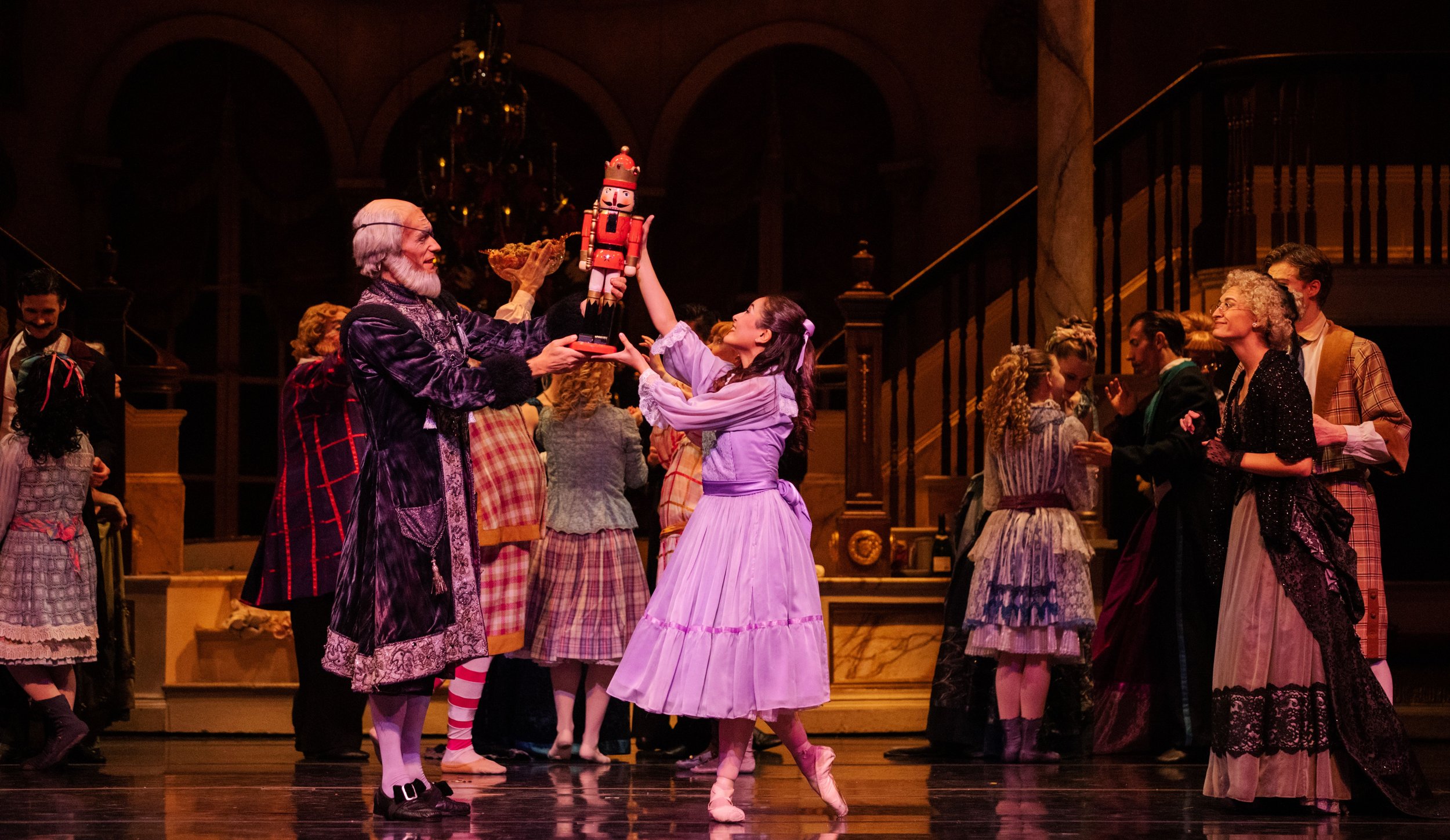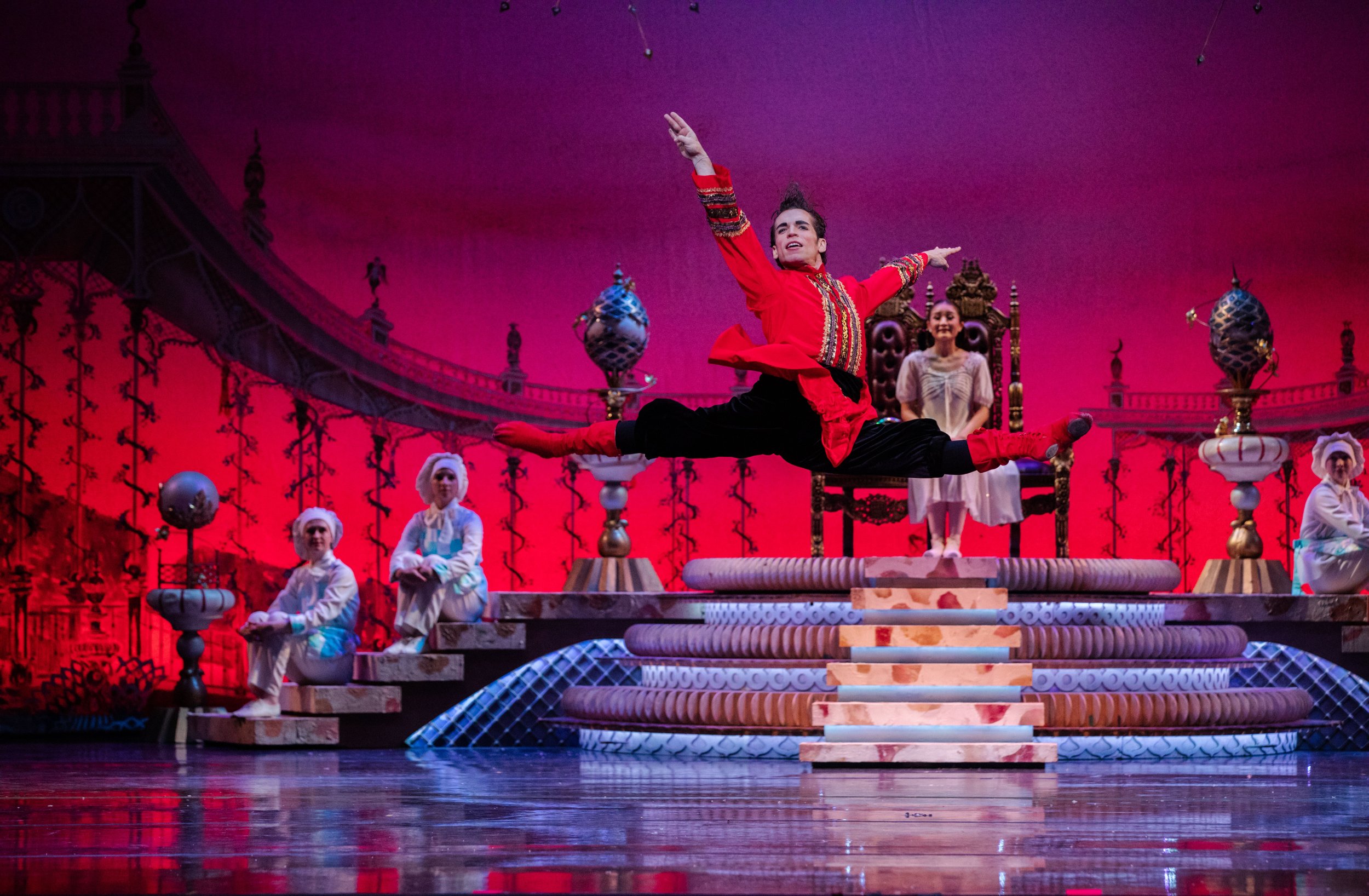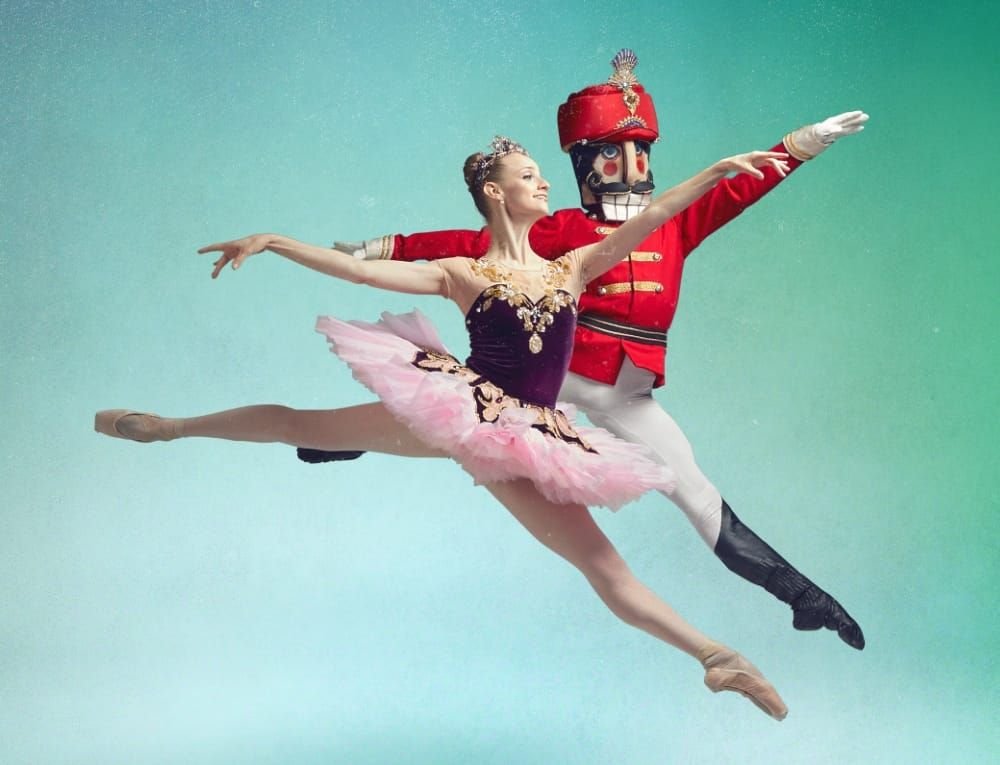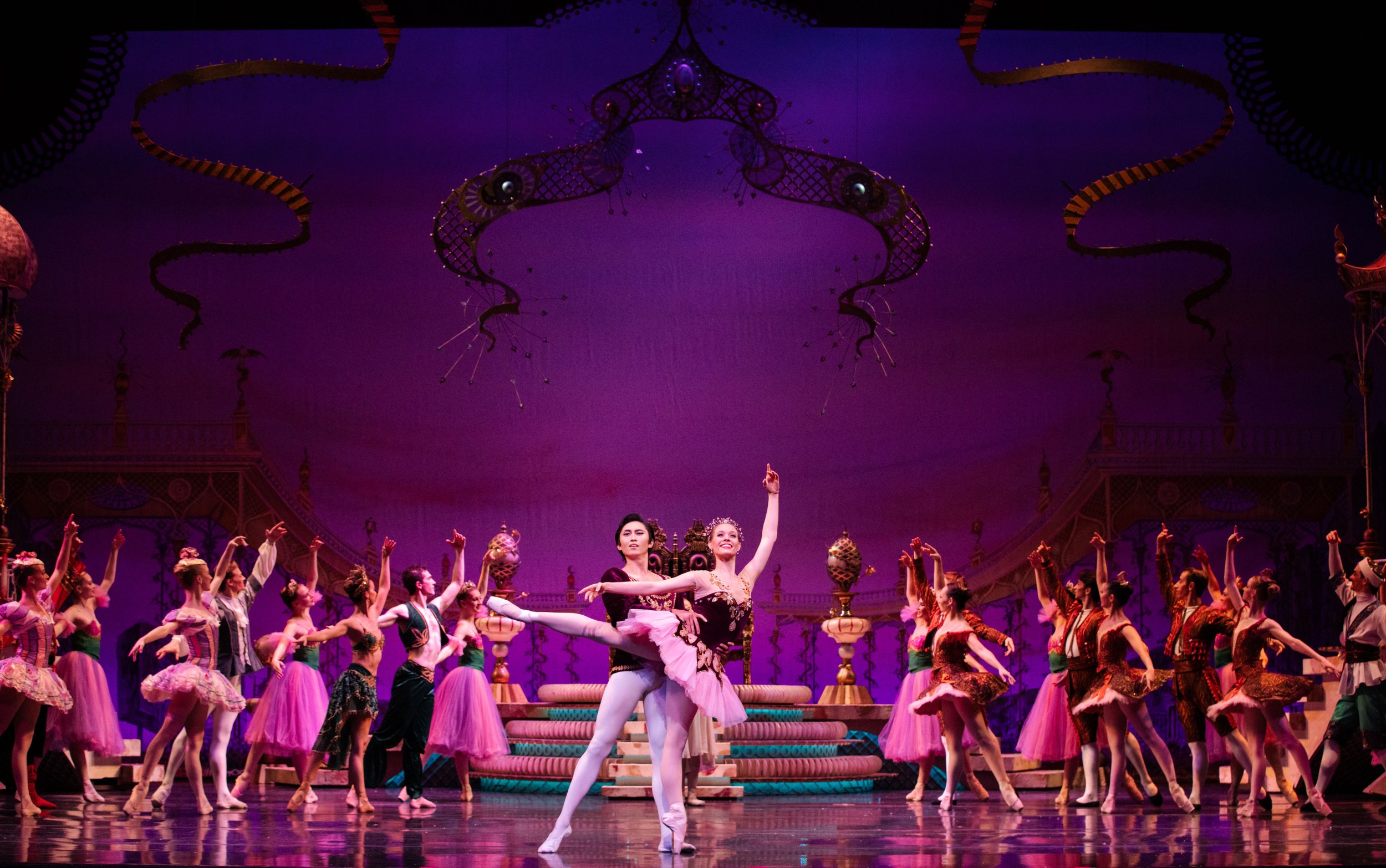The Nutcracker @ Texas Ballet Theater (Winspear)
Photos by Amitava Sarkar and Steven Visneau
—Review by Gregory Sullivan Isaacs
You know it’s the Christmas/holiday season when you begin to note the proliferation of grumpy Scrooges, clusters of choristers, and dancing mice (etc.) roaming the streets. Can multiple productions of A Christmas Carol, Handel’s Messiah (really an Easter piece if you think about it), and of course Tchaikovsky’s much-loved ballet The Nutcracker be far behind?
To tell the truth, I tend to avoid many of the seasonal shows. First of all, once you start—when do you stop? Review just one production and you can expect complaints from the others, especially as they serve as vital fundraisers for performing arts companies large, medium, and small.
But this year, tossing caution to the snowy winds, I attended the opening night of the Texas Ballet Theater’s Nutcracker at the Winspear Opera House—pulled in by the opportunity to see world-famous choreographer Ben Stevenson’s version of the piece: starring dancer Ben Stevenson (of the Sadler’s Wells Royal Ballet, the English National Ballet), Order of the British Empire, longtime head of the Houston Ballet and then the Texas Ballet Theater—and now the company’s Artistic Director Laureate. And creator of ballets including The Nutcracker, Coppelia, Peer Gynt, The Sleeping Beauty, and many more.
And it was wonderful, of course, combining eye-popping stagecraft, lavish sets, colorful costumes, technically faultless dancing, particularly enchanting character development, and choreographed comedy that bordered on the vaudevillian. Stevenson smoothed out some of the original version’s violence, minimized a few characters and promoted/created others, touched up the untouchable, and streamlined the flow of the entire production.
But while each of the soloists, major and minor, were uniformly spectacular, the real standout was…well, everyone else. The first act is a Christmas party at the home of a wealthy family. Usually, the stage is filled with homogenized, formally dressed guests milling about—what you’d call “extras” or (as in opera) “supernumeraries.” Stevenson makes them all separate characters, each with their own personality, physicality, presence, and even peccadillos. They are guests arriving for the festivities, and we learn a lot about them from the way they saunter across the stage during the overture. Although we didn’t realize it at first, this little parade was our introduction this wonderful array of people—even before the curtain opened.
The story’s central character, Clara, is a charming girl on the edge of womanhood, and company Trainee AvaRose Dillon (all cast listings are for the night reviewed) fits the bill. Her bratty brother Fritz was played by Harrison Pickering. In many productions, these two are mostly actors with little in the way of dancing duties. Stevenson has carefully choreographed them with more dance than usual, using it to bring out their personalities.
Clara’s godfather, the mysterious Drosselmeyer, is danced with silent-movie exaggeration by Alexander Kotelenets. He is dressed in equally exaggerated and sequined evening clothes, and his magnificent cape seems to have a mind of its own. As gifts, he brings a pair of boxes that contain two live-sized puppets (not really) dressed in 16th-century Italian commedia dell’arte garb. The dancers playing Colombine and Harlequine (Rieko Hatato and Valentin Batista) must also be mimes, as the dance made clear that their limbs were wooden and their joints hinged. In one funny bit, the spinning dancer slapped whoever was close and no one seemed to learn from the experience.
The great showdown between the Nutcracker, danced by David Schrenk, and the corpulent, multi-headed King Rat, danced by Joamanuel Velazquez, teeters effectively on the edge of scary—but keeps on the comic side, happily avoiding a freak-out among the youngest members of the audience. (In the second half, of course, Schrenk’s Nutcracker turns into the Nutracker Prince, and is danced by Andre Silva.)
When the clock strikes midnight, the real magic begins. Ask almost anyone who has seen this ballet “What’s your favorite part?”—and most respond that it’s the moment when the bedecked Christmas tree suddenly grows to immense proportions. What is really happening, of course, is that the characters are shrinking (shades of Alice in Wonderland). Now they are tiny creatures in the Land of Snow (ruled by Snow Queen Paige Nyman and Snow Prince Carl Coomer, cool customers both), where dancing snowflakes are only the start of the fun.
The ballet corps is either the pride or downfall of any production. They must be precisely together with every motion, even in the placement of their hands when they are posed and not physically moving. Any deviation is noticeable to the audience. Stevenson’s corps was splendid in this regard.
The next stop on the itinerary is the Land of Sweets, a dream indeed for most children. The Sugar Plum Fairy is a role reserved for the prima ballerina assoluta, either imported or a special member of the company. On opening night, I saw TBT’s Nicole Von Enck dance the role effortlessly and with striking poise. Her movements were crisp yet liquid, and her extensions were mind-boggling. When assisted, she could touch her knee to her ear.
The second act is always a problem. Clara sits enthroned while gleefully watching as a series of ethnic dances in traditional garb are presented for her amusement. Each represents a sweet or treat, as well as a dance associated with the country or origin.
They are:
The Spanish Dance (chocolate), performed with crisp authenticity by pairs Katelyn Rhodes/Henry Winn, RayleighVendt/Harrison Pickering, Anastasia Tillman/Adam Phillips…the sinewy Arabian Dance with Rieko Hatato and Riley Moyano (the “treat” this time is coffee, not a sweet but very exotic in Tchaikovsky’s day)….The Russian Dance represents candy canes and usually has the most athletic male dancing of the ballet. On opening night Andre Silva took the role, and didn’t disappoint. His high flying leaps brought some gasps from the audience.
The Chinese Dancers offer tea, which was unknown in the west until it was imported by Portuguese priests and merchants in the early 16th century. The dancers, Valentin Batista and Velazquez, descended from the heavens in large tea cups and delivered the most questionable of the ethnic dances. In what was almost a parody, their arms remained extended and bent at the elbow with the index finger pointed up.
The Mirliton Dance found some of the corps dressed in tutus that resembled the trays worn by cigarette girls in Roaring Twenties nightclubs. A mirliton can be a rustic flute or a knobby vegetable—or, apparently, the old-fashioned sweet known as marzipan—a long-ago Christmas treat in some countries, and colorfully interpreted by Dara Oda, Hannah Wood, and David Schrenk.
Let’s not forget the hilarious star turn that Jackson Bayhi took as Madame Bonbonaire (more traditionally called Mother Ginger) in her gigantic hoop skirt. From under and out of its folds came her many children, students of the TBT’s dance school, who danced around in an engagingly random manner. And the Waltz of the Flowers, with Samantha Pille and Kyle Torres-Hiyoshi and artists of both Texas Ballet Theater and the Studio Training Company, was a study in precision dancing: they seemed to float, not even touching the floor.
One of the highlights of any Nutcracker performance is the grand pas de deux (dance for two) of the final moments—on this night, brought off gorgeously by Nicole Von Enck’s lithe Sugar Plum Fairy and Andre Silva as her strikingly handsome cavalier, the Nutcracker-turned-Prince. Partnering is a skill that is difficult to master and some dancers just never make the grade. But Silva was perfect in this role. He allowed Von Enck to get all the attention. He steadied her in otherwise impossible displays of balancing, propelled her so she could make dozens of multiple turns, gracefully lifted her above his head, and lowered her to the ground as if she were a wisp riding the smoothest of thermal waves. In the moving lifts, he vanished from our attention in such a way that she appeared to be flying.
The only disappointment was the unfortunate but expected use of over-amplified pre-recorded music. One can understand the economies of the decision, considering the huge cost of a live orchestra (especially for a long run)—yet it’s still a pity to miss some of the glories of a live score. However, there’s no question that the dancing was as “live” and electric as one could wish—and that Stevenson’s take on Tchaikovsky’s masterpiece is a holiday joy.
WHEN: Plays in Dallas through December 4, and from December 9-24 in Fort Worth
WHERE: Winspear Opera House, Dallas; Bass Performance Hall, Fort Worth
WEB: For info and tickets go to: attpac.org , basshall.com



